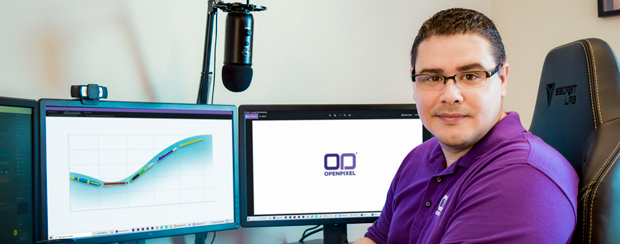As a small animation business, our company, Open Pixel Studios, is always looking for ways to work faster, better, smarter. The game changer for us? Workflow automation.
Since automating our sales pipeline last year, project estimates that once took hours to produce now take minutes. And the time we used to spend laboring over estimates is now applied to our creative effort.
Our whole mantra is that you should be focused on your role, and your role should always be creative in some way. Automation empowers us to do that while freeing us to focus on the higher-value work we enjoy most.
“Since time management is so important to our business, we’re always looking at new and better ways to quantify our time and become more productive.”
Increasing productivity
Workflow automation is a fairly simple concept: By connecting your tech tools together—so they automatically share data —you can eliminate many of the repetitive and recurring tasks that sap employees’ time. It allows us to be more strategic about time management.
Animation is a tough business in terms of determining the cost of a project and predicting how much time it will take. Not only are we trying to balance the type of creative work we do—we also need to make sure we are paid for it fairly and put in the effort that we are charging for. Since automation gives us more control over our time, it allows us to better do that.
We use the software app Zapier (it rhymes with happier) to sprinkle the magic dust. It’s a fantastic tool for connecting various web services together and allowing those different services to share data points. In our case, we’re currently using Zapier to connect 15 apps, including Airtable, Dropbox (cloud storage), Harvest (time-tracking), Teamwork (project management), QuickBooks (accounting), Zoom (video conferencing) and Google Sheets (spreadsheets). Airtable, which tracks our sales and the progress of every project, is the central hub for all of our data, and it’s the one that—to use non-technical terms—plays the biggest role in our automation.
Zapier works on triggers and actions. For any trigger that happens on any platform, there is at least one action. Here’s what that often looks like: When a potential client clicks “Schedule a Call” on our website, their contact info gets stored in Airtable. Zapier then accesses it to help generate an estimate using cost analyses from past projects, among other data points.
Navigating challenges
Workplace automation doesn’t come without challenges. I am the head of sales and, with flow automation, had to effectively become the lead IT person. But as someone who grew up using technology, it was an easy transition.
There’s a learning curve, for sure, but I get joy out of figuring out how to do these things. I think of it as reverse-engineering where automation can be injected. It takes time up-front, but once it’s in place, I no longer have to think about it. There’s this freeing sensation knowing that, once set up, this is going to take place the way I wanted it.
But the challenges are nothing compared to the benefits. We’re definitely planning to automate further, including our marketing, creative management and finance. There’s absolutely no reason automation shouldn’t be at least partially implemented in every part of our business.
Finding future potential
I see great potential in rolling out automation in various ways across our organization. In finance, for example, we’re looking at ways to use Zapier to deliver quarterly reports to the right people and trigger the delivery of invoices. When we deliver a finished project, it goes into a specific folder in Dropbox that’s tagged as final. Once that happens, an invoice could automatically be sent out, eliminating the need for a human to send it.
The area in which we are making the most progress is the handoff between sales and our creative staff. Oftentimes, sales folks are doing their own thing without fully understanding the creative effort needed to complete the project—so there’s a disconnect between how someone sells the project and the technical creative needs of that project.
With Zapier, our animation leads get an alert basically saying “here’s a project coming from sales,” along with a detailed breakdown of the requirements. The notifications give our creative directors a chance to fully understand what the project creatively requires before the work starts.
Since time management is so important to our business, we’re always looking at new and better ways to quantify our time and increase productivity. Workflow automation has been incredibly helpful.
Print this article



0 Comments